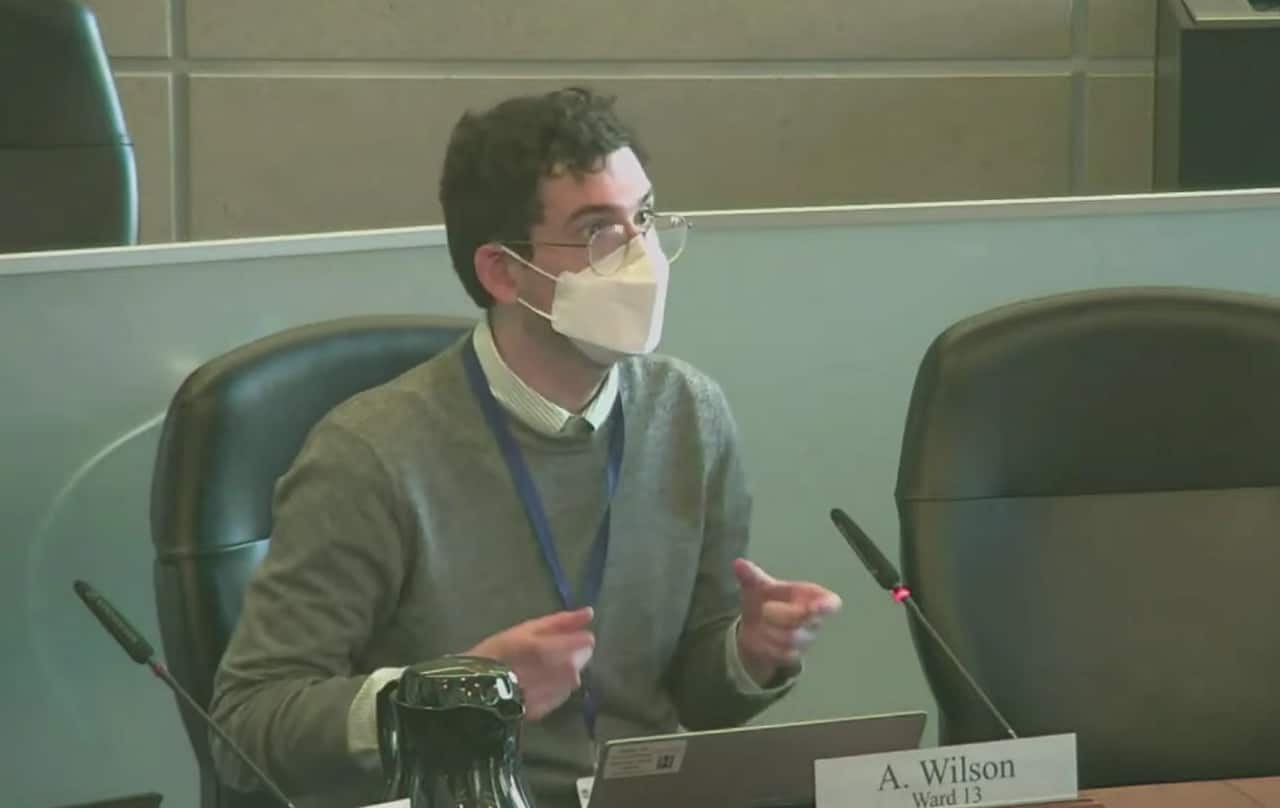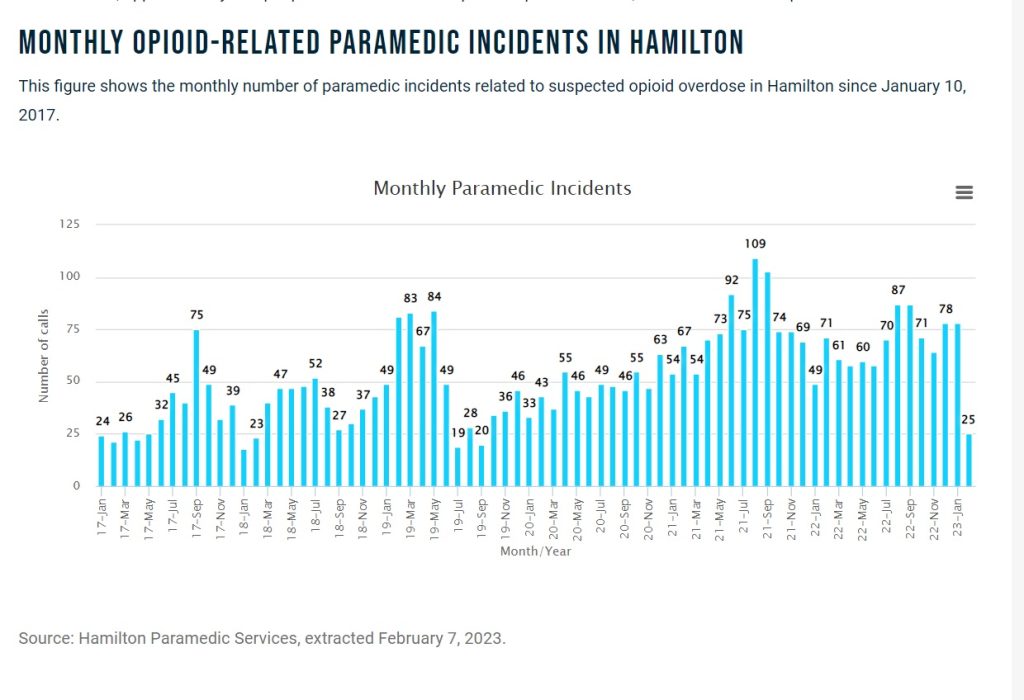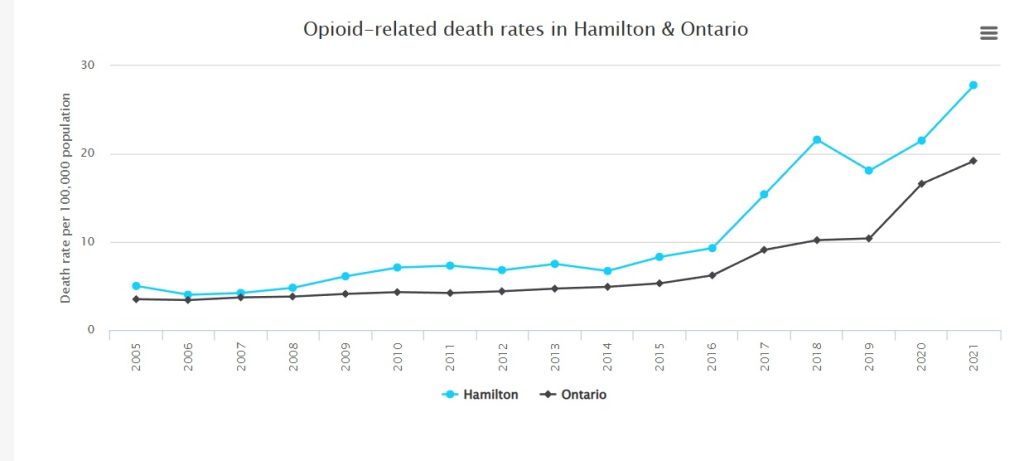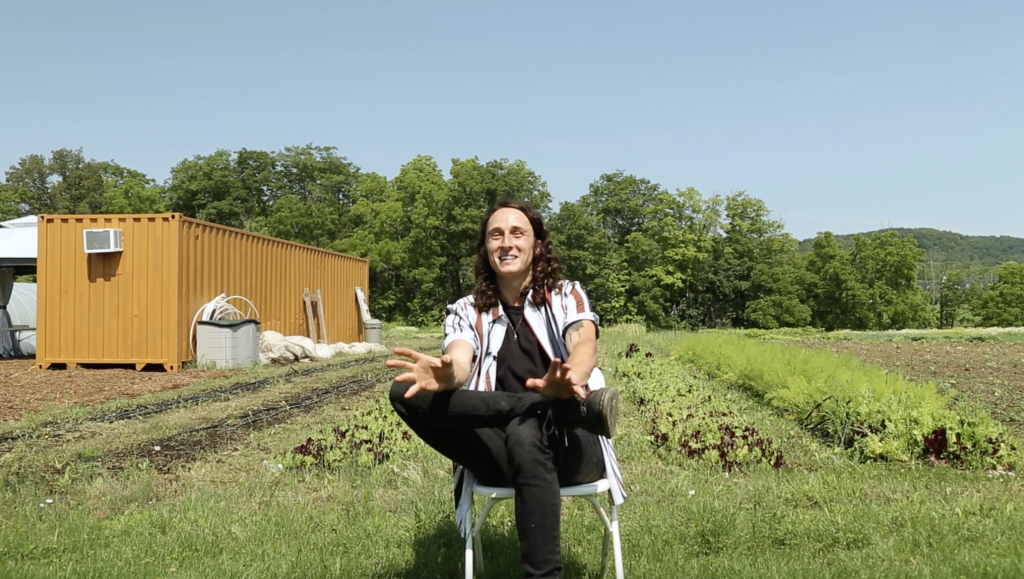Safe use spaces in Hamilton shelters, to reduce opioids deaths, is up for debate
Published February 9, 2023 at 6:06 pm

Dundas-area Coun. Alex Wilson is proposing for the city of Hamilton to study whether safer use spaces in shelters would be one way to deal with the knock-on costs from the intersecting housing crisis, opioids epidemic, and global COVID-19 pandemic.
City council is evaluating whether to declare a state of emergency after five consecutive years where at least 100 people in Hamilton have lost their lives after using opioids. That includes 139 people who died in the first 10 months of last year. The opioids-related death rate, on an annual basis, has ranged from 30 to 111 per cent above the provincial average even as rises across Ontario. The Hamilton Paramedics also responded to 827 overdose calls in 2022, and have already hit the century mark this year.
Ward 9 Coun. Brad Clark noted, “Every single ward in the City of Hamilton has had overdoses,” last month when councillors voted 12-0 to have the city’s medical officer of health examine the potential efficacy of declaring a state of emergency. That is the subject of one of the three reports related to harm reductions that is will be heard at a board of health (BOH) meeting on Monday (Feb. 13).
At that meeting, Ward 13 rep Wilson will move a motion entiled, “Advancing a Whole-Community Harm Reduction Framework.” It calls for directing staff to develop an action plan that must look at creating safer use spaces in the community. Their motion notes that there is already one good example, at the YWCA Hamilton, where a safer use space is reducing the financial strain on the paramedics.
“Adequately funded harm reduction services would create cost-savings to other municipal and frontline services,” Wilson’s motion states. ”
“The YWCA Hamilton has been operating a safer use space since late April 2022 to present. As of January 19, 2023, the program has served 176 unique guests and successfully reversed 34 drug poisonings. There have been zero calls made to police and one call made to EMS (the parademics) that did not require transfer to hospital.”

Staff would have to come back with an action plan by June 12. The motion, as written, would also call on city staff to “to track and document all deaths related to toxic drugs” and pass that on the BOH by the end of the calendar year. Currently, death rates are drawn from provincial data.
Olivia Mancini and Kim Ritchie, two Hamilton social workers who are involved with the Canadian Drug Policy Coalition, are delegating to council on Monday. Ritchie, in her request, reminded the city that COVID-19 supports from senior level of governments are set to expire soon.
“As we see COVID funding being slowly eroded from our public health and social service sector, we’re witnessing an unprecedented number of overdoses within the Hamilton shelter system,” Ritchie wrote to council. “All these deaths are preventable as substance dependency needs to be met with pragmatic and coordinated solutions, which are available.”

Other potential coordinated solutions that will also be reviewed next week include:
- Potential supports for The AIDS Network (TAN) application for a second CTS site (consumption and treatment services) site at 746 Barton St. E.;
- A report on how to proceed with a harm reduction outreach project that will be funded through Health Canada’s Substance Use and Addictions Program;
- An information report about how public health services would respond if city council were to declare a state of emergency in regard to opioids.
Taken in order, the first report avers that “supervised consumption is a key intervention to provide safe options for those who use substances.” It advises council that there are three different streams — only one of which requires Ontario Ministry of Health approval — for adding safer use spaces.
The application for potential The AIDS Network-managed will require a sign-off from both senior levels of government. More than 40 Ward 3 residents have contributed letters of support. The Hamilton Health Sciences and St. Joseph’s Healthcare Hamilton hospital networks, Hamilton Public Library, De dwa da dehs nye>s Aboriginal Health Centre, and more than 25 businesses, community groups and public-facing institutions have also written in support.
It also notes that city council could give the application an extra bit of polish.
“Additional letters of support from individual councillors are also welcomed,” reads the report, prepared by Melissa Biksa of Hamilton Public Health (HPH). “Given the existing motion is not address specific, the Ministry has encouraged The AIDS Network as the applicant to obtain municipal council support with the full address of the proposed CTS.”
Secondly, HPH will be asking council for the go-ahead on the harm reduction outreach. The federal funding runs through March 31, 2025 and would be used to cover the pay of The AIDS Network staff who will work in the project.
The public health unit has a mental health and street outreach program, but it has not had the resources to “meet the needs of individuals being referred and the need for consistent outreach services,” a report reads.
Emergency declaration may not yield much action
City council declared the opioids poisoning epidemic as a crisis in 2019. Lastly, but not leastly on Monday, public health is briefing councillors about the declaring a state of emergency. It notes that Ontario has no such funding outlet; disaster relief funding only covers natural events such as floods or the derecho storm last spring.
“While Hamilton would benefit from additional funds to further respond to the opioid crisis, an official declaration would not lead to the provision of funds,” the report reads.
It notes that Hamilton has been moving in a progressive direction on harm reduction for several years, and adds that a “renewed local opioid response plan” will be presented at a BOH meeting in four months, on June 12.
That would be at the same time that the action plan Wilson is proposing would need to come back to city council.
All of the business on Monday will come in the wake of council being divided over how to include health-care professionals and people with lived experience on the BOH.Hamilton’s health board, by rule, is chaired by the mayor and formed by the 15 councillors. Creating a semi-autonomous board of health with citizen representatives would require the province to amend the City of Hamilton Act and the Health Promotion and Protection Act.
At the regular council meeting on Wednesday, there was a 9-7 vote in favour of further study of health board restructuring options. Mayor Andrea Horwath voted with eight councillors — seven of whom are white males — from the Mountain, Stoney Creek, and urbanizing wards.
All four lower-city councillors, as well as two whose wards have a high proportion of seniors (Ward 12 Coun. Craig Cassar and Wilson from 13) and one who is a senior (Ward 15 Coun. Ted McMeekin), were on the short end of the vote.
However, it was Clark, who represents an area of Stoney Creek, who moved for studying a state-of-emergency declaration in regards to opioids back on Jan. 12. And at that meeting, Couns. Matt Francis (5), Tom Jackson (6), John-Paul Danko (8), Jeff Beattie (10), Mark Tadeson (11), and Mike Spadafora (14) each voted in support.
(Graphics: City of Hamilton.)
insauga's Editorial Standards and Policies advertising






